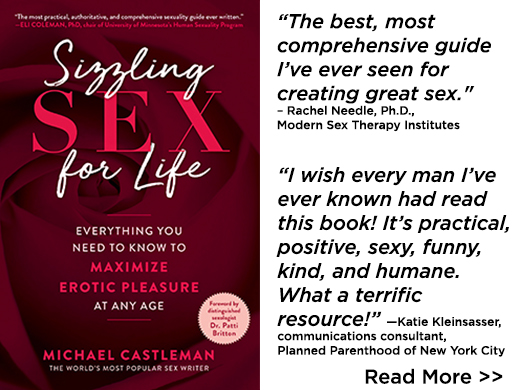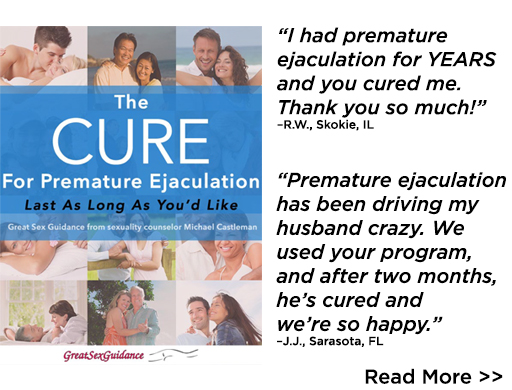
Many people believe that graphic media depictions of sex spur real live sex. But despite sex all over TV, pornography just a click/tap away, and lascivious lyrics in many popular songs (e.g. Cardi B’s hit “WAP” for “wet ass pussy”), recent studies show that since 2000, partner sex has declined, and celibacy—no partner sex at all—has surged. Today, among American men age 18 to 24, almost one-third report no partner sex during the previous year, and in other age groups, partner lovemaking has also declined and celibacy risen.
Partner Sex: Going, Going … Gone?
Documentation of the general decline in sexual activity is based not on small studies of college students, but from huge, nationally representative surveys sponsored by some of the nation’s most credible research organizations. The most recent evidence comes from the General Social Survey (GSS), based at the University of Chicago’s National Opinion Research Center and funded by the National Science Foundation. GSS has conducted in-depth surveys almost annually since 1972e. The GSS is the largest and most comprehensive ongoing study of Americans’ attitudes and behavior across a large number of beliefs and activities—including sex.
GSS investigators interviewed 9,504 Americans aged 18 to 44 (average age 31) in 2000-2002 and again 16 years later in 2016-2018 (when participants were on average 47). Over that period, men—mostly unmarried men—reported the greatest jump in abstinence from partner sex—10 percent to 17 percent. Men reporting intercourse weekly or more dropped from 60 percent to 47 percent.
Men age 18 to 24 reported the greatest increase in celibacy —in 2000-2002, 19 percent, in 2016-2018, 31 percent. In men 25 to 34, sexual inactivity also increased, but less—from 7 percent to 14 percent. And in men 35 to 44, celibacy remained about the same, but partner lovemaking weekly or more fell from 61 percent to 50 percent.
Most men like to think of themselves as studs. Other studies have shown that men tend to overstate their sexual frequency. Now men report decreased partner sex. Makes me wonder if their real decrease might be even greater.
Among women, celibacy also increased, but less. Women age 18 to 24 reported an increase from 16 to 20 percent, and women 25 to 34 from 6 to 10 percent. In women 35 to 44, partner sex frequency remained about the same.
These figures mirror another GSS report that tracked partner sex among adults of all ages for the dozen-year period from the late-1990s through 2010. The interviewers asked 26,620 people how often they did the deed. Intercourse frequency decreased by nine times per year. Cohabitating or married individuals reported the greatest drop in partner sex. Partner sex declined from 65 times a year (around five times a month) to 53 times (about four). (Frequency was age-related. Coupled people in their twenties reported partner sex six to seven times a month compared with once or twice a month for those in their sixties).
The National Survey of Family Growth (NSFG) also shows considerable celibacy. It’s sponsored by the National Center for Health Statistics, a division of the Centers for Disease Control and Prevention. NSFG investigators conducted face-to-face interviews with 12,571 Americans (4,928 men, 7,643 women) age 15 to 44. Among the men, 10 percent had never experienced partner sex, with 6 percent saying they’d had intercourse, but not in the past six months. Among the women, 6 percent said they’d never had partner sex, with 7 percent reporting celibacy during the previous six months.
Similar decreases in partner sex and increases in celibacy have also been documented in England, Australia, Germany, and Finland.
Why Less Sex?
Different researchers advance different reasons, but in general, they point to several factors:
• Age. In contrast to the myth that young adults use phone apps to hook up almost nightly, in all genders, young people, particularly students, are the most celibate. Their rate may be rising because they now spend so much time on the Internet (below).
• Steady partners. Compared with those cohabitating or married, singles are much more likely to be celibate. But couples are also having less sex, in large part because of the following reasons.
• Children at home. Compared with couples who don’t have minor children at home, those with kids typically have less partner sex.
• Employment. Most women want men who have good jobs. Compared with men who work full-time, those who work part-time or not at all have more than twice the rate of celibacy. The rise of freelance and gig work—less secure than official jobs—may play a role in the trend to increased male celibacy. The situation for women is different. Unemployment carries no sexual penalty. In fact women who don’t work have a bit more sex than those who do.
• Income. For all genders, as income increases, the celibacy rate falls. Increased celibacy may be related to the much-observed shrinking of the middle class.
• Longer commutes. The researchers disagree on this one. Some say longer commutes mean less partner sex, but most say commute times don’t matter. However, long commutes are associated with relationship stress. Over the past 20 years, commute times have risen, and with them, possibly celibacy as well.
• Religion. Compared with nonbelievers, those who call themselves religious report less sex. This hasn’t changed in 20 years. What has changed is the shrillness of the liberal-conservative culture war over sex, possibly reducing sex further in those who are deeply religious.
• Geography. Residents of cities and suburbs are more likely to be celibate than people who live in rural areas. This contradicts the income factor. Those in cities and suburbs typically earn more. But in the former, housing prices have soared, meaning that more of high salaries must pay for rent or mortgages. After those expenses, many rural folks retain more of their income, which may explain the fact that they have more partner sex.
• Internet use in general. As Internet use increases, partner sex usually decreases. The Internet is around 20 years old. It’s become ubiquitous—and increasingly a black hole. The Internet is hypnotic—and armies of psychologists work overtime make sites and apps irresistible and sticky. So time spent on the Internet has increased, leaving less time for something else.
• Internet pornography. While the increasing use of the Internet typically hurts partner sex, those who watch Internet porn have more partner sex than those who don’t. Interest in porn usually reflects an interest in sex.
• Race. Race does not play a major role in celibacy. But compared with black men, whites and other races are a bit more likely to be celibate. It’s the opposite for women. Compared with black women, whites and others are a bit less likely to report celibacy.
The Upside of Less Sex
The trend toward increased celibacy is welcome in one group—teens. The teen birth rate peaked in 1991 and since then has fallen to a record low, in part because of less sex, and in part because today’s teens usually use contraception. In the past few years, there’s been a slight uptick in births to teens, but overall, the teen birth rate remains very low by post-World War II standards. In addition, today’s teens wait longer than previous generations to marry, meaning more time single, which usually means less sex.
The Trend Line Favors Conservatives, Who Don’t See It
Increasing celibacy has implications for the culture war over sexuality. Conservatives blame permissive culture and sex-drenched media for casual sex and so-called “sex addiction,” which they abhor. Actually, despite sexual permissiveness and increasingly explicit media sex, the trend is toward less partner sex and more celibacy, especially among conservatives’ chief targets, young people. Ironically, conservatives are so skeptical of science, and so convinced the country is sinking into a quicksand of sexual depravity that, apparently, they haven’t noticed that the trend line is actually moving in the direction they favor.





